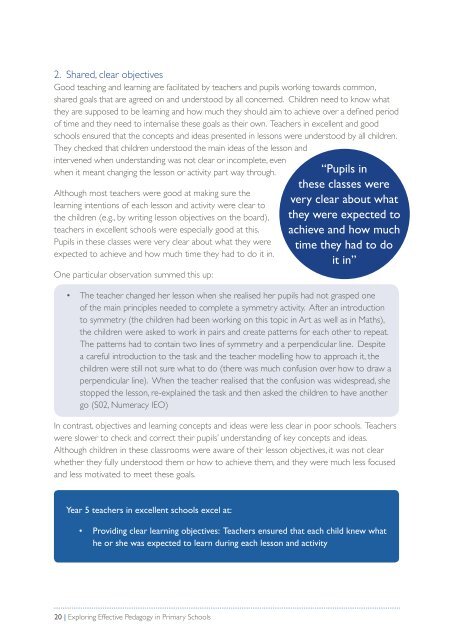Pearson-Exploring-Effective-Pedagogy-in-Primary-Schools
Pearson-Exploring-Effective-Pedagogy-in-Primary-Schools
Pearson-Exploring-Effective-Pedagogy-in-Primary-Schools
Create successful ePaper yourself
Turn your PDF publications into a flip-book with our unique Google optimized e-Paper software.
2. Shared, clear objectivesGood teach<strong>in</strong>g and learn<strong>in</strong>g are facilitated by teachers and pupils work<strong>in</strong>g towards common,shared goals that are agreed on and understood by all concerned. Children need to know whatthey are supposed to be learn<strong>in</strong>g and how much they should aim to achieve over a def<strong>in</strong>ed periodof time and they need to <strong>in</strong>ternalise these goals as their own. Teachers <strong>in</strong> excellent and goodschools ensured that the concepts and ideas presented <strong>in</strong> lessons were understood by all children.They checked that children understood the ma<strong>in</strong> ideas of the lesson and<strong>in</strong>tervened when understand<strong>in</strong>g was not clear or <strong>in</strong>complete, evenwhen it meant chang<strong>in</strong>g the lesson or activity part way through.Although most teachers were good at mak<strong>in</strong>g sure thelearn<strong>in</strong>g <strong>in</strong>tentions of each lesson and activity were clear tothe children (e.g., by writ<strong>in</strong>g lesson objectives on the board),teachers <strong>in</strong> excellent schools were especially good at this.Pupils <strong>in</strong> these classes were very clear about what they wereexpected to achieve and how much time they had to do it <strong>in</strong>.One particular observation summed this up:“Pupils <strong>in</strong>these classes werevery clear about whatthey were expected toachieve and how muchtime they had to doit <strong>in</strong>”• The teacher changed her lesson when she realised her pupils had not grasped oneof the ma<strong>in</strong> pr<strong>in</strong>ciples needed to complete a symmetry activity. After an <strong>in</strong>troductionto symmetry (the children had been work<strong>in</strong>g on this topic <strong>in</strong> Art as well as <strong>in</strong> Maths),the children were asked to work <strong>in</strong> pairs and create patterns for each other to repeat.The patterns had to conta<strong>in</strong> two l<strong>in</strong>es of symmetry and a perpendicular l<strong>in</strong>e. Despitea careful <strong>in</strong>troduction to the task and the teacher modell<strong>in</strong>g how to approach it, thechildren were still not sure what to do (there was much confusion over how to draw aperpendicular l<strong>in</strong>e). When the teacher realised that the confusion was widespread, shestopped the lesson, re-expla<strong>in</strong>ed the task and then asked the children to have anothergo (S02, Numeracy IEO)In contrast, objectives and learn<strong>in</strong>g concepts and ideas were less clear <strong>in</strong> poor schools. Teacherswere slower to check and correct their pupils’ understand<strong>in</strong>g of key concepts and ideas.Although children <strong>in</strong> these classrooms were aware of their lesson objectives, it was not clearwhether they fully understood them or how to achieve them, and they were much less focusedand less motivated to meet these goals.Year 5 teachers <strong>in</strong> excellent schools excel at:• Provid<strong>in</strong>g clear learn<strong>in</strong>g objectives: Teachers ensured that each child knew whathe or she was expected to learn dur<strong>in</strong>g each lesson and activity20 | <strong>Explor<strong>in</strong>g</strong> <strong>Effective</strong> <strong>Pedagogy</strong> <strong>in</strong> <strong>Primary</strong> <strong>Schools</strong>


